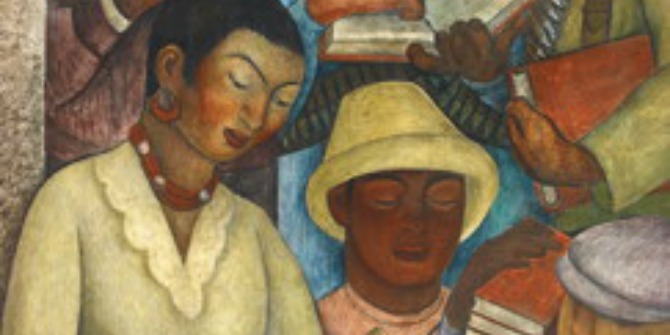 Today, when one thinks of the border separating the United States from Mexico, what typically comes to mind is a mutually unwelcoming zone, with violent, poverty-ridden towns on one side and an increasingly militarized network of barriers and surveillance systems on the other. In Why Walls Won’t Work, Michael Dear explains why this view is problematic and false. Those interested in one way that the discipline of border studies has developed to account for the post 9/11 context will find this book interesting and instructive; Dear’s focus on the physicality of the border Wall itself is most convincing, writes Zalfa Feghali.
Today, when one thinks of the border separating the United States from Mexico, what typically comes to mind is a mutually unwelcoming zone, with violent, poverty-ridden towns on one side and an increasingly militarized network of barriers and surveillance systems on the other. In Why Walls Won’t Work, Michael Dear explains why this view is problematic and false. Those interested in one way that the discipline of border studies has developed to account for the post 9/11 context will find this book interesting and instructive; Dear’s focus on the physicality of the border Wall itself is most convincing, writes Zalfa Feghali.
Why Walls Won’t Work: Repairing the US-Mexico Divide. Michael Dear. Oxford University Press. 2013.
In a 1984 lecture entitled Latin America: At War with the Past in Toronto, Carlos Fuentes controversially noted that “Latin America begins at the Mexican border […] It is the only frontier between the industrialized and the developing worlds. It is the frontier between two cultures: the Protestant, capitalist, Nordic culture, and the southern, Indo-Mediterranean, Catholic culture of syncretism and the baroque” (p.7-8). It is this essentialist and problematic position that is disputed in Michael Dear’s Why Walls Won’t Work: Repairing the US-Mexico Divide.
Anyone who has an interest in the US-Mexico border will know of the controversies surrounding the communities living in the border region. Those groups living in the borderlands are, as Dear confirms, among the most misunderstood as well as being those who most effectively contest the imposition of national identities from the political state to which they “belong.”
Dear’s book, a useful and timely contribution to border studies, comes as a result of Dear’s own travels along and across this border, and he insists that his experiences “provide a powerful rejoinder to those who would abandon the Mexican border to the drug cartels, or to those in the US who would use the borderlands as a surrogate battlefield against migrants.”
In the first chapter, Dear traces a brief history of the survey work done along the border in the wake of the 1848 “Treaty of Peace, Friendship, Limits, and Settlement” – known more colloquially as the Treaty of Guadalupe Hidalgo – that formally ended the war with Mexico which had started two years earlier. This chapter brings to mind Rachel St. John’s 2012 study Line in the Sand: A History of the Western U.S.-Mexico Border, but its focus on the post 9/11 context of the boundary sets it apart from the majority of recent studies of this most contentious border. Interestingly, Dear suggests that the border has further become a place of mistrust as a result of the physical boundary that has been constructed along the political border: “The fence has created a mean place.”
But this “mean place” sees its counterpoint in the literal borderlands, according to Dear. Perhaps the most optimistic perspective he offers is that of the “third nation”, which he elaborates upon in chapter 5 and 6. As he notes, “a ‘third nation’ is a community carved out of the territories between two existing nation-states” (p.71). Accordingly, a third nation “is an ‘in-between’ space, transcending the geopolitical boundary that divides the constitutive nation-states and creates from them a new identity distinct from the nationalisms of the host countries” (p.71). Dear’s remarks here are reminiscent of many of the “first” theorists of the US-Mexico border. One of the most prominent, Gloria Anzaldúa (only briefly mentioned in this chapter), emphasizes the great potential of US-Mexico borderlands as being simultaneously a site of hostility, where “the Third World grates against the first and bleeds” (Borderlands/La Frontera 25) as well as a place “wherever two or more cultures edge each other, where people of different races occupy the same territory, where under, lower, middle and upper classes touch, where the space between two individuals shrinks with intimacy” (Borderlands 19).

This focus on the potentially liberatory function of living in the borderlands is echoed in Dear’s analysis; he is “confident in describing this place [the borderlands and twinned border cities] as a third nation. Its material connectivity is long-established and deep; and its cognitive foundations are articulated by residents with nuance and precision” (p.104).
How the physical border wall interacts with those living in the borderlands and constituting this “third nation” is clear – it is both a necessary evil and an artificial edifice that serves to emphasize, as Fuentes would have it, the supposed “difference” between those groups living on each side of the border.
The most pithy – and effective – of Dear’s chapters outlines why he does not see the Wall working. These concluding remarks revolve around the border as long having been a place of connection, both in terms of borderlanders’ mental mapmaking, and in terms of cultural, historical, and economic cross-border connections. And it is Dear’s final diagnosis that ends the book: “Left untended, the US-Mexico Wall would collapse under the combined assault of avid recyclers, souvenir hunters, and local residence offended by its mere presence. Nevertheless, we should preserve sections of the Wall to commemorate that fraught moment in history when the US lost its moral compass” (p.177).
Those interested in one way that the discipline of border studies has developed to account for the post 9/11 context will find this book interesting and instructive; Dear’s focus on the physicality of the border Wall itself is the most convincing I have read in some time. The Wall, by Dear’s accounting, not only exacerbates the tensions Carlos Fuentes so problematically identified 30 years ago, but causes them. In this moment of the US government shutdown, it is crucial that the underlying logic behind the Wall be re-evaluated.
Please read our comments policy before commenting.
Note: This article gives the views of the authors, and not the position of USApp– American Politics and Policy, nor of the London School of Economics.
Shortened URL for this post: http://bit.ly/16kVGMQ
—————————————–
 Zalfa Feghali – Canterbury Christ Church University
Zalfa Feghali – Canterbury Christ Church University
Zalfa Feghali is Lecturer in Modern American Literature at Canterbury Christ Church University. Her previous research focused on the relationship between contemporary American and Canadian poetry, citizenship, and civic acts of reading and her current project traces a literary history of North American citizenship. She is an avid ukulele player and can be followed on twitter @zalface. Read more reviews by Zalfa.





